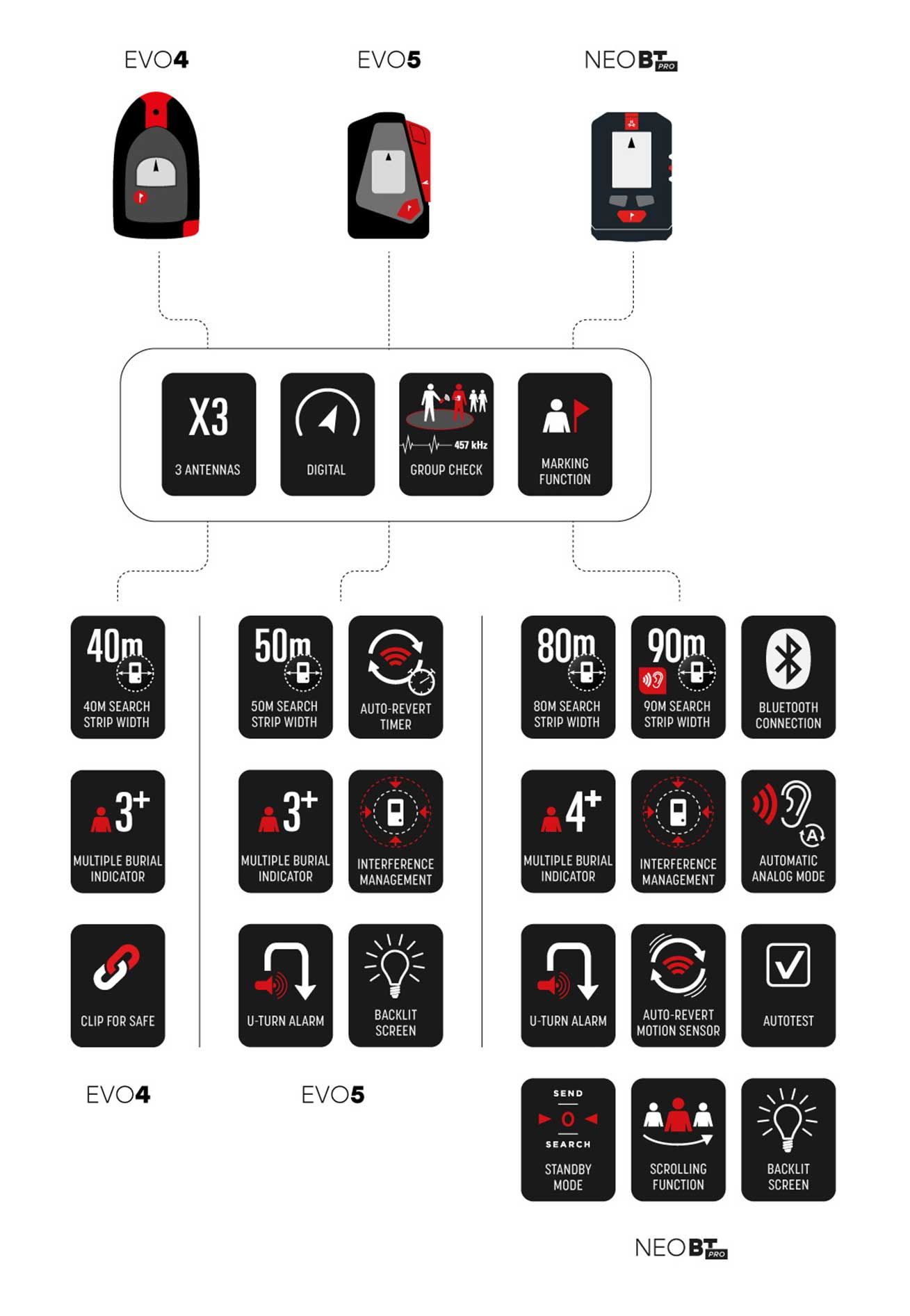CHOOSING YOUR AVALANCHE TRANSCEIVER
What is an avalanche transceiver ?
An avalanche transceiver (or beacon) is a piece of equipment that emits and receives a signal in order to rescue someone or be rescued in the event of an avalanche. This means that someone wearing a transceiver can rescue someone buried beneath the snow if the latter is also wearing a transceiver. This device helps to save precious minutes before search and rescue professionals arrive on scene.
Choose the right transceiver by reviewing the performance characteristics and features that you need. A device’s performance is expressed in search strip width. This means the width of an area the device is capable of “scanning” to indicate whether or not an avalanche victim is buried in the area. In addition to this, there are several other functionalities or search options that you might need.

How to choose your avalanche transceiver ?
All ARVA transceivers include certain standard functions that enhance performance and make them simple and easy to use. All of our devices are digital, equipped with 3 antennas, and feature the marking, group check, and auto-test functions.
Three-antenna transceiver
The three antennas provide distance information in three dimensions. The main antenna, also referred to as the Y antenna, is the longest antenna. In transmit mode, it emits the signal, and in receive mode, it provides greater range. The secondary or X antenna orients then signal. This antenna provides reliable directional information. The third or Z antenna provides depth information during the fine search to avoid the multiple spike effect. Combining these three antennas provides a full signal.
Digital transceiver
Through digital processing, the signal is then translated into a distance and a direction indicated by an arrow. The search is made much easier through clear, visual indicators.
As digital avalanche transceivers have become the standard in the avalanche safety device market, the difference between the models is now based more on the processor speed. This can become more apparent during the fine search phase, the cross-search when you get closer to the victim. So you will have to be careful not to go too fast, depending on your device. Carrying out a preliminary simulation is very useful as it gives you an idea of the speed to adopt in a search situation.
The quality of the information displayed on the screen may also vary between the different models, depending on whether it is sunny or overcast.
Usable range and search bandwidth
These two concepts are often confused, but they are extremely important in choosing your transceiver. The effective range is the maximum distance at which your transceiver can receive a signal. The search bandwidth is twice the useful range.
So, when you are in the middle of a flow, if your useful range is 30 metres, you will be able to receive a signal from the victim if they are within 30 metres on your right and on your left, that is to say, 60 metres in total. The greater the effective range, the greater the chances of picking up the victim's first signal.
Group Check, Self-test and Victim marking
The auto-test is also a standard feature on all of our devices. It checks to make sure the device is working properly as soon as it is turned on : transmit, receive, and battery life.
The group-check feature allows you to make sure that everyone in your group is wearing a transceiver and that their transceivers are transmitting properly.
The marking feature rounds out all of these useful and essential functionalities. During a multiple burial search, the marking feature allows you to isolate and eliminate the signal of a victim who has already been found in order to focus on the next burial.
The key accessory : the holster
If you are not familiar with the transceiver holster, here is an illustration. The holster is essential for keeping your avalanche transceiver as close as possible to you while allowing you to move around easily. Remember, in the event of an avalanche, an avalanche transceiver placed in your trouser pocket, for example, could be swept away by the snow. So it is better to have it as close as possible to you, in a holster, which also guarantees you maximum freedom of movement.

Our avalanche transceivers

ARVA EVO5
EVO5, A miniature beacon : the EVO5 is the smallest DVA ever designed by the ARVA brand. Measuring only 11 cm in height and 7 cm in width, it is one of the most compact beacons on the market. Its size and light weight of 170 g allow it to be barely noticed while worn without neglecting performance in an emergency situation.
ARVA EVO4
The EVO4 is our simplest transceiver to use. In addition to a 40-meter search strip width, it includes all standard features to ensure a maximum level of safety without increasing the complexity of a burial search. This is the perfect device for novices or occasional users.
ARVA NEO BT PRO
The practical Bluetooth-connected NEO BT PRO covers an 80 m search strip width. Connect your device to the ARVA app: configure it, prepare for your trip and even train for rescue!
ARVA NEO BT PRO NEO BT PRO SAFETY PACK

Looking after your transceiver
Like any electronic device, a regular check is essential to ensure your transceiver is in good working order. A check may be necessary to recalibrate your transceiver frequency; it is normally set to 457 kHz. In addition to the frequency, the batteries should be checked regularly. Below 50 % of their capacity, we recommend changing the batteries in your transceiver. Moreover, using rechargeable batteries for your avalanche victim detector is prohibited because they are not suitable for use in mountain temperatures.
To maximise the life of your batteries, you can remove them at the end of each season, replacing them for the next season.
Next step: learn how to use your transceiver !
Find our online avalanche safety and rescue training programme.